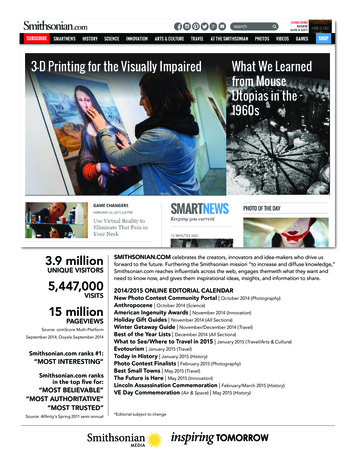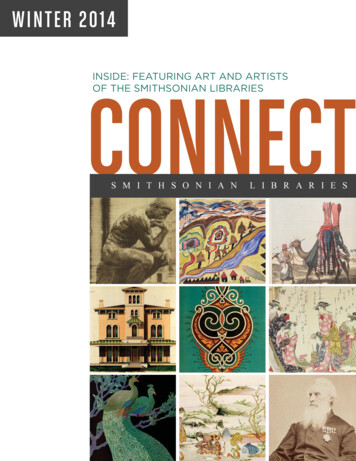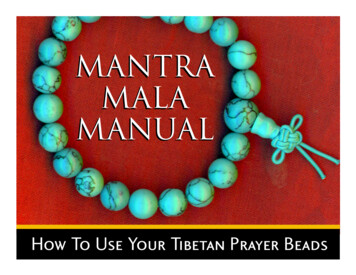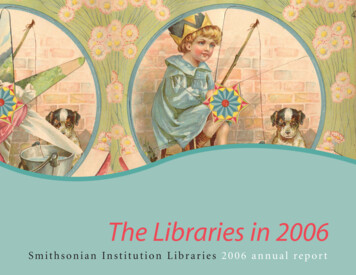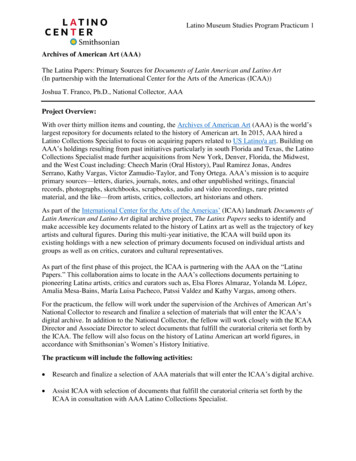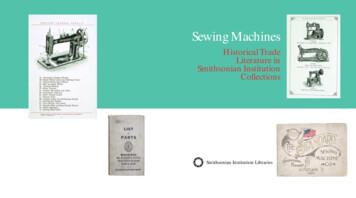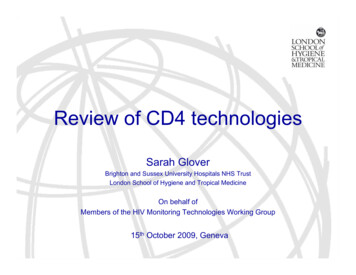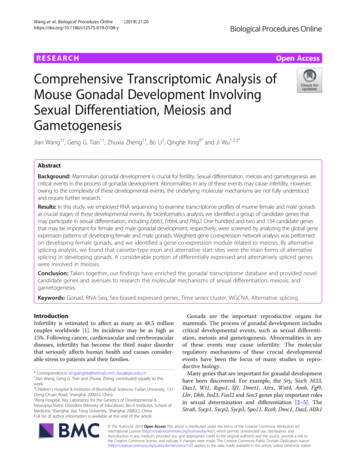
Transcription
a life inBEADSThe Stories a Plains Dress Can Tell
A Life in Beads: The Stories a Plains Dress Can Tellgrade levels: 4–6 time required: 4 class periodsOverviewIn this poster, students will be introduced to three generationsof Assiniboine (pronounced Uh-SINNA-boyn)/Sioux(pronounced SUE) women who make traditional dresses.Through their stories and their art, students will learn aboutthe importance of preserving Native culture and see howfamilies share and pass down traditions. Students will gain anunderstanding of the ongoing Plains traditions of beadworkand quillwork—decorative arts done with beads and porcupinequills—and the “giveaway” (an honoring celebration). Studentswill explore the significance of designs and symbols found ondresses and better understand the Plains peoples’ long-standing,close connection to their surroundings and natural resources.edge a male family member’s valor, or to recognize a sacrifice.In most cases, men painted the battle scenes on dresses. A dresswith these images would only be worn by a family member:a wife, mother, sister, daughter, or granddaughter.The Assiniboine and Sioux are two separate tribes fromthe Northern Plains region, both situated on the Fort PeckReservation in northeastern Montana. They are just two nationsout of more than 550 Native nations in the United States todaywho still adorn their clothing, accessories, and other implementswith materials that reflect their surroundings and relate theirbeliefs and values. Each Native nation expresses itself in its ownunique way—using different colors, symbols, designs, and mate rials. The Sioux are made up of three distinct but related groupsthat are separated by language dialects: the Lakota, Dakota,and Nakota—and those groups are further divided into severalbands. The Fort Peck Sioux include the Sisseton/Wahpeton,Yanktonai, Cuthead, Oglala, and Hunkpapa bands. The FortPeck Assiniboine are from the Canoe Paddler and Red Bottombands. This poster features the perspectives and values ofthree generations of women who are Assiniboine/Sioux, givingstudents an opportunity to explore some important Plainstraditions that have been carried on for many generations.Curriculum Standards for Social StudiesCulture: Performance Expectations A, CPeople, Places, & Environments: Performance Expectations B,HObjectivesIn the lessons and activities, students will be able to: Identify the historic Assiniboine and Sioux territoriesand present-day location of the Assiniboine/Sioux Name three Assiniboine/Sioux traditions and gainan understanding of their cultural significanceNote to teachers: The instructional content of the poster isdesigned to be photocopied, but you can also download fullsize pdfs of the maps on the web at: www.nmai.edu/education. Identify some of the resources used to make traditionaldresses and where those resources are foundProceduresDisplay the poster in the classroom. Explain to studentsthat they will be learning about some of the cultural traditionsof the Assiniboine/Sioux. (Review and practice pronunciationof “Assiniboine/Sioux.”) Explain that they are actually twoseparate tribes from the Northern Plains area. Understand the meaning behind some symbolsfound on American Indian dressesBackgroundNative women have always had an important role in preserv ing cultural traditions and values. The elaborately beadeddresses that Plains women made—and still make and wear—are both beautiful garments and outward expressions of theirtribal identity and family values. Historically, dresses were thecanvases upon which Plains women expressed their creativity,marked significant events (such as marriage or a familymember’s military service), and displayed family pride.Provide a brief introduction to Plains states and tribes.To view a map and a list of Plains tribes go to: www.bbhc.org/collections/pim and click on “Map of cultural regions and tribes.”Download the pdf file (Figure 2) of the map of Montana,featuring Fort Peck. Point out the historic territories that theAssiniboine and Sioux inhabited and the location of the FortPeck Reservation, present-day home to the Assiniboine/Sioux.For historic background on these two nations, a timeline ofImages found on early painted muslin dresses were often meantto honor an individual’s accomplishments in battle, to acknowl 1Reproducible 1.1
(1,1) -1- NMAI Poster Interior BlueCX 031507.indd 3/20/07 2:04:17 PMevents, and how they both came to reside on the Fort PeckReservation, go to: www.usd.edu/ iais/siouxnation/FtPeck/tribhist.html or www.montana.edu/wwwfpcc/tribes/Short.html.4. Explain why Native people of the Plains still use naturalmaterials to make dresses today.Map Activity: Print out and distribute the elk and porcupinemaps (Figures 1 & 3). Point out Montana in the elk map.Select students to read aloud the information containedwithin the maps, including the keys. Ask the following ques tions of the class and select students for answers.Next, have the class examine the poster front, think aboutthe images, and talk about what the images tell them aboutthe Assiniboine/Sioux. Have them compare the styles of dressin the images and talk about the differences. Ask them to lookclosely and try to identify the materials on the dresses, whatthey are made of, and the occasions on which they mighthave been worn. Prompt thinking with questions, e.g., Whatdoes it look like the dresses are made of? Where do you thinkthey got the material? Who do you suppose made the dresses?(Questions are designed to establish students’ ideas, percep tions, and starting knowledge of Plains Indians and clothing.)1. Refer to Figure 2 and find where the Assiniboine andSioux are located today. According to Figure 1, whenwould the Assiniboine have found elk more plentiful?2. Name one state where you would not hunt elk in 1850.3. What does the map tell you about the elk populationtoday versus 1850?4. What are the two main materials needed to make an elktooth dress? According to the map, would these materialsbe easy to find in Assiniboine or Sioux territories in 1850?5. If you were to make a quilled elkhide dress, what two mainmaterials would be needed? In 1850, who might have aneasier time finding quills, the Assiniboine or Sioux? Why?6. What materials are your clothes made of? Where do thematerials come from?Write the word TRADITION on the board. Ask students todefine it in their own words. Select a student to look up theword in the dictionary, read the definition, and write it on theboard. Engage the class in a discussion of how traditions getstarted and why they are important. Ask students to think oftheir own family traditions and share answers.Resources and MaterialsPlains Dresses: Print out Reproducibles 2.1, 2.2,and 2.3 and distribute to the class. Read the text aloud andPrint out Reproducibles 1.1, 1.2, and 1.3. With theclass, read the passages, focusing attention on maps, images,and captions. On the board, write the following questionsand have students provide answers on their own papers.Review answers with class.pause to refer to the pictures, also reading the captions.Plains Dresses: “Layers of Meaning” Review Questions.1. How are Plains dresses different from your specialoccasion clothes?2. What material might be used to decorate a Plains weddingdress? How are Plains wedding dresses different from theones you are familiar with?3. What are the three main Plains traditions discussed inthe passages? (ANSWER: beading, dressmaking, and thegiveaway celebration)4. What is a giveaway and why do Native people have them?Why do they give away horses?5. What/who did the “Give Away Horses” dress honor?6. Based on the reading, how are Plains traditions oftenpassed down? Why is it important for Plains traditionsto be passed down?A. Resources and Materials Review Questions1. How did men and boys contribute to the makingof dresses?2. How do men show their respect for the animals theykill on a hunt?3. How did women contribute to the making of dresses?B. Decoration and Adornment Review Questions1. What were the first paints made out of? What were thefirst paintbrushes made out of?2. Besides paints, what were some of the first materials usedto decorate Plains clothing?3. Why is quillwork more difficult than beading?2Reproducible 1.2
(1,1) -1- NMAI Poster Interior BlueCX 031507.indd 3/20/07 2:02:02 PMDiscuss with the class the importance of symbols andhow they communicate values. Use the Give Away Horsesdress as an example of symbols that represent the valuesof family and traditions.Have students draw their own dresses and shirts using theirown designs and symbols. The idea is not to create an “Indiangarment,” but shirts and dresses decorated with symbolsthat have special meaning according to their own values andculture. Students should be creative in coming up with theirown symbols to represent family, animals, or other things thathold great value for them. The symbols they choose mightdepict respect, love, and honor. Dresses can be in honor ofa parent or grandparent. Assist students in thinking aboutpossible symbols, such as roses, stars, hearts, and others, andabout the meanings attached to them. Have students write anexplanation of what their dress or shirt means to them anddisplay their work in class. To explore more about symbols andhow an unrelated culture—Chinese culture—used symbols onclothing, see: www.phm.gov.au/hsc/evrev/chinese dress.htm.Sioux dress with dentalium shell yoke, ca. 1900. Detail to right.Photos by Ernest Amoroso, NMAI.ResourcesTo see and learn more about Plains dresses and objectsfeatured in the National Museum of the American Indianexhibit, Identity by Design: Tradition, Change, and Celebrationin Native Women’s Dresses, go to: www.nmai.si.edu and clickon “Exhibitions.”For further information on other decorative material usedon Plains dresses and the introduction of glass beads on thePlains, go to: www.bbhc.org/pim/faq.cfm.All images on poster National Museumof the American Indian, except as noted.Poster Front Photo CreditsMain image:Sioux two-hide dress with fully beaded yoke, ca. 1865.Photo by Ernest Amoroso, NMAI.Image retouching by Angelia Collins, NMAI.Insets, left to right:Arapaho woman wearing cloth dress decorated with elk teeth (detail), 1898.Photo by Frank A. Rinehart or Adolph F. Muhr.Hunkpapa Lakota (Sioux) cloth dress (detail), ca. 1890.Photo by Ernest Amoroso, NMAI.Sioux girl in beaded dress, ca. 1890. Photographer unknown.Sioux dress with dentalium shell yoke (detail), ca. 1900.Photo by Ernest Amoroso, NMAI.Oglala Sioux woman wearing cloth dress decorated with elk teeth, ca. 1890.Photo by William Henry Jackson.To learn more about elk, their habitat, and elk conservationefforts, visit: www.rmef.org.AcknowledgmentsSpecial thanks to Joyce, Juanita, and Jessica Growing ThunderFogarty (Assiniboine/Sioux); Emil Her Many Horses (OglalaLakota), NMAI; and Kakwireiosta Hall (Mohawk/Cherokee)Project Manager, Writer, Developer: Leslie Logan (Seneca), NMAIEditors: Edwin Schupman (Muscogee), Genevieve Simermeyer(Osage), Elizabeth Gische, NMAIDesign and Production: Grafik, Alexandria, VA3Reproducible 1.3
(1,1) -1- NMAI Poster Interior BlueCX 031507.indd 3/20/07 2:21:17 PMReproducible 1.1Resources and Materials Used to Make DressesCANADAMTNative people used what was available in their surround ings. In the Northern Plains area, the hides most oftenused for clothing first came from buffalo, elk, deer, andmountain sheep. Dresses and shirts were mostly madeout of deerhides and elkhides because the skins werethinner, while the thicker buffalo hides were used asrobes or blankets.The making of a dress took a great deal of work, whichstarted with a hunt. Men hunted the animals fromwhich the hides came; women did the work of preparinghides. Native people of the Plains have always main tained a close relationship to the land and its resources,and expressed their respect for the animals they took.While on a hunt, they offered prayers in thanks for thelife of the animal, its spirit, and for all that the animalwould provide. Today, Assiniboine/Sioux men still say aprayer and offer tobacco—which helps send the prayer—and promise to make good use of the animal.Adapted from Rocky Mountain Elk Foundation.n the late 1600s, before modern-day borders wereestablished, the Assiniboine migrated south toMontana from Canada. The Sioux gradually movedto the areas now known as Montana and the Dakotasfrom Canada and Minnesota beginning around the mid1800s. The Assiniboine and Sioux found the area teemingwith wildlife, including buffalo, elk, deer, antelope, andmountain sheep. These animals were important for theirmeat and for the hides that provided clothing and shelter.UNITED STATESMEXICOFIGURE 1Elk in North AmericaPast and PresentElk Ranges todayElk Ranges circa 1850PRESENT-DAY CANADAFIGURE 2Historic Assiniboineand Sioux AreasAssiniboine Areas circa 1850Sioux Areas circa 1850Fort Peck Reservation, est. 1888AssiniboineFort PeckReservationMTSiouxAdapted from Ives Goddard, “The Languages of the Plains: Introduction,”Handbook of North American Indians, v. 13, part one, p. 62, Smithsonian Institution, 2001.Reproducible 2.1
(1,1) -1- NMAI Poster Interior BlueCX 031507.indd 3/20/07 2:24:53 PMReproducible 1.2The women work to prepare the hides by removing thehair and tanning the skin. It is messy, hard work andrequires muscles and brains—the muscles of the women,and the brains of the animal! In one tanning method,the hide is first soaked in water mixed with ashes forseveral days. Then it is put on a wooden frame and thehair is scraped off. Next, cooked brains of the animal areapplied to the hide in order to soften it. The hide is thenrinsed and stretched and pulled until—as one dressmakersays—your arms are “so tired, they feel like they willfall off!” This process is referred to as “brain-tanning”and is still done today to prepare hides that will be madeinto dresses, shirts, jackets, purses, and other items.Sioux women preparing/tanning hides, ca. 1890. Photo byG. Ben Whittick. General Nelson A. Miles Collection, NMAI.Decoration and Adornmentative people of the Plains have long decoratedtheir clothes and objects. Today, the heavilybeaded dress is often thought of as thetraditional style of clothing for Plains women. But beforetraders brought glass beads to the Plains, the materialsused to decorate outfits for men and women came fromthe natural environment. Some of the earliest dressesand shirts were painted with natural materials, knownas earth paints. Minerals and clays were among the firstmaterials that would often be combined with buffalo fatand mixed in bowls made out of turtle shells to makepaints. The hip bone of a buffalo, which when soakedin water becomes sponge-like, was sometimes used asa paintbrush. The painted images found on many earlyhides and dresses show scenes of men on horses inbattle or on a hunt. They tell stories of the bravery andhonor of a husband, son, or father.In addition to paints, people of the Plains used othernatural materials to adorn their clothing. Most oftenthe materials used were porcupine quills; animal teeth,such as those of elk; bone; bird or animal claws, suchas those of bear; and shells that were most oftenacquired through trade with other tribes or non-Natives.The designs on dresses and the materials used reflectthe people’s respect for the animals and the land.Left: Early “paintbrushes” made of porousbuffalo bone. Photo by Ernest Amoroso, NMAI.Right: Painted Hunkpapa Lakota (Sioux) cloth dress(detail), ca. 1890. Photo by Ernest Amoroso, NMAI.Reproducible 2.2
(1,1) -1- NMAI Poster Interior BlueCX 031507.indd 3/20/07 2:26:48 PMReproducible 1.3Lewis and Clark Journal Entry:Capt. Lewis, May 3, 1805—near the entranceof the river, we saw an unusual number ofPorcupines from which we determined tocall the river after that anamal [sic], andaccordingly denominated it Porcupine river[now called the Poplar River].Poplar River(formerly Porcupine River)Meriwether Lewis and William Clark, The Journals of the Lewis andClark Expedition. Edited by Gary E. Moulton. Lincoln: The Universityof Nebraska Press, 1983–2001.uriMerRivFort Peck LakeoissMONTANAFort PeckReservationCANADAFIGURE 3Poplar River, Fort Peckand Porcupine HabitatCANADAMTPorcupine Population*US* The North American porcupine populationhas remained relatively stable over time.In the past, elk teeth on dresses symbolized wealth andreflected the value the people of the Plains placed onthe elk. Today, mountain designs on dresses show howthey value the land and surroundings.Porcupines are found along rivers and streams in greatnumbers in the Northern Plains. The sharp, needle-likequills that grow on porcupines were among the firstmaterials used to decorate clothing. Porcupine quillswere softened, flattened, and wrapped or woven aroundother material. They were also dyed different colors andused to make detailed designs. Natural materials such asplants, flowers, and berries were used to dye quills.The process of beading is much easier than quillwork,since the quills have to be pulled from the hide, washed,dyed, dried, sorted by size, and then softened in themouth and flattened. Although more difficult and timeconsuming than beadwork, quillwork is still done byPlains artists today. Native people of the Plains continueto use the natural resources from their surroundings tomake dresses. Today, they may buy hides and materi als, or may hunt and gather what they need. Either way,they still honor the animals and the land—and the waysof their grandmothers, grandfathers, and ancestors ofgenerations past.Top: Porcupine quills vary in length and thickness and have to besorted. The best quills often come from the sides of the porcupine.Photo by Katherine Fogden, NMAI.Bottom: Sioux quilled robe (detail), ca. 1880. Hide, sinew,porcupine quills, seed beads, and brass bells. Photo by WalterLarrimore, NMAI. The quill design indicates that this robe wasprobably used during an adoption ceremony. During theceremony, a child would be adopted by a member of thecommunity, who would act much like a godparent today.Reproducible 2.3
(1,1) -1- NMAI Poster Interior BlueCX 031507.indd 3/20/07 2:33:45 PMReproducible 2.1Plains Dresses: Layers of Meaningll cultures celebrate special occasions and eventsin people’s lives. In honor of celebrations, peopleoften dress up and wear certain clothes or itemsto fit the occasion. Can you think of some special occa sions for which you dress up? What do you wear?Among the Assiniboine and Sioux, two Northern Plainstribes from Montana, cultural events and celebrationsrequire special attire. For girls, special attire can be abeaded dress made of elkhide or deerhide—or a clothdress covered with shells, elk teeth, or cone-shaped tin“jingles.” For men and boys, it might be a beaded outfitconsisting of a belt, moccasins, vest, headband, andother items.honor of family members. Long ago, the decorations ona woman’s dress signaled her family’s ability to tradefor materials, or that her husband or father was a goodprovider. Many elk teeth on a dress meant great wealth.In the Crow tribe, dresses covered in elk teeth weresometimes given to a new daughter-in-law by herhusband’s family. The only elk teeth used on dresses arethe two ivory eyeteeth. In the past, a boy would collectelk teeth over many years of hunting and would savethem to be sewn by his mother or sisters on a dress forthe woman he would marry. (See poster front, historicimage of woman in elk tooth dress.)Some special occasions for which Plains people weartraditional clothing today are weddings, naming cer emonies (where a person gets a name in their Nativelanguage), community celebrations, honoring “give aways” (celebrations in which things of value are givenaway to honor someone), and powwows (Native dancefestivals and competitions). Whatever the occasion, thepeople of the Plains have always taken great pride inwearing their traditional clothes, sometimes referred toas regalia. A tremendous amount of time and effort goesinto making regalia. For the girls and women of Plainstribes, the dress that one wears for special occasions ismore than just a pretty dress.A dress connects a girl to her tribe, her community,her family, and her ancestors. The dresses that girls andwomen wear are full of meaning, sometimes decoratedwith beads in designs and symbols that tell stories inLeft: Four Sioux girls wearing beaded dresses,ca. 1890. Photographer unknown.Above: NMAI National Powwow, 2005.Photo by Walter Larrimore, NMAI. This youngman wears a heavily beaded vest and apronwith buffalo designs. On his back he wears afeathered bustle.
(1,1) -1- NMAI Poster Interior BlueCX 031507.indd 3/20/07 2:35:48 PMReproducible 2.2Generations of Dressmakersoyce Growing Thunder Fogartyis Assiniboine/Sioux, whichmeans she comes from boththe Assiniboine and Sioux tribes ofFort Peck, Montana. She also comesfrom a long line of dressmakers andbeaders (people who do beadwork). Shehas beaded for most of her life. Joyce wasrecently awarded a Lifetime AchievementAward by the Southwest Associationof Indian Arts, earning her the titleof “master beader.” She has beadeddresses, vests, jackets, dolls, purses, belts,hatbands, moccasins, baby carriers or cradleboards, andhorse “masks.” Once, she was even asked to bead moc casins for a dog. Joyce says that over the years she hasprobably beaded 250 belt buckles, all of which she hasgiven away as gifts. When she made her first traditionalSioux dress for herself, it took her two years. She beadsfor a living, she beads as a hobby in her spare time, shebeads because, as she says, beading is “in my blood.”Juanita, Joyce, and Jessica Growing Thunder Fogarty, 2006.Photo by Emil Her Many Horses, NMAI.As a child, Joyce picked upher skill and love for this artform by watching her Siouxgrandmother, who raisedher and was always beadingdresses. Her grandmother’sinfluence has also trickled down to her daughterJuanita and her granddaughter Jessica. Three generationsof beaders are going strong inthe Growing Thunder family, all of them award-winningbeaders, who produce beautiful works of art.Jessica Growing Thunder Fogarty is seventeen years old.She has been beading since she was three and has wonawards for her work since she was twelve. “I grew upevery day of my life watching them and learning. Theynever sat me down andtaught me how to bead.I just watched them,” saysJessica of her mother andgrandmother. Her motherJuanita says that Jessica hasa natural talent for beading.But Jessica says, “My momand grandma have told methat I was born with it, butAbove: Joyce Growing Thunder Fogarty drapesI think watching them hasthe beaded top of the unfinished Give AwayHorses dress across her granddaughter Jessica.given me my talent.”Photo by Emil Her Many Horses, NMAIAbove Center: Lakota Sioux beaded horse mask.The highly regarded horse of a Teton Sioux worethis beaded mask in the 1904 July 4th parade atPine Ridge, S.D. Photo by NMAI Photo Services.The Give Away Horses Dress: A Dress Rich with Honor and Historyhe National Museum of the American Indiancommissioned the Growing Thunder family tomake a Plains dress outfit for the 2007 exhibit,Identity by Design: Tradition, Change, and Celebration inNative Women’s Dresses. The outfit includes accessoriessuch as moccasins, leggings, belt, purse, and other items.Joyce and Juanita are used to spending a lot of timebeading, but during the summer of 2006, they arosedaily at three or four in the morning to begin working onthe outfit, and then beaded for sixteen hours a day, sevendays a week—averaging more than 110 hours a week.The dress made for the exhibit is extra special. Made outof elkhide, it is beaded with Sioux designs and revealsAssiniboine influences. Everything on the dress stands forsomething important to the family, reflects their sur roundings, and reinforces their cultural values. Its beadeddesigns tell the story of how Joyce’s grandparents paidtribute to the grandchildren. Her creation, in turn, paysrespect to her grandparents, Ben and Josephine GrayHawk. It is a dress that honors the family from one gen eration to the next in a cycle of honoring.
(1,1) -1- NMAI Poster Interior BlueCX 031507.indd 3/20/07 2:37:02 PMReproducible 2.3Joyce refers to the dress as the “Give Away Horses Dress”because it tells the story of how her grandfather held agiveaway celebration in which he gave away horses inhonor of his grandchildren. “My grandfather raised a lotof horses and gave away a lot of horses. He’d get a spe cial horse and get it ready for the honoring. He wouldtie a war bonnet on its mane, and people would be onfoot with ropes and he’d have the announcer announcethe giveaway. They would let the horse go and crack thewhip; it would take off and everyone would go runningafter it, trying to get it. That’s how it was done,” explainsJoyce. “Down the road, I would like to do that.”The dress illustrates the importance of the family andshows how traditions are passed down. “They are stillgiving away horses,” says Joyce. “They do that to honortheir grandkids, or the younger ones do it to honor theirgrandparents. The horses are of great value and that,in turn, signals the value of the family.”Joyce thinks back on her younger days when shehelped her grandmothers make dresses. “I think abouthow it used to be watching them and how luckyI was to be raised by them,” Joyce says. She oftenmisses them. But they are still with her all the time inspirit—in fact, it is the work on the dresses that con nects her to her grandmothers. “My grandmothers didit and I’m carrying on the traditions,” she says. It iswork that connects Jessica to her grandmother as well.“The beading brings us together,” says Jessica. Her momJuanita agrees. “It strengthens us as a family, because itgives everyone a purpose and self-worth, culture, andidentity,” she says. “We know what our background is,and it ties us to the culture.”The traditions will likely carry on in the GrowingThunder family. Joyce learned from her grandmoth ers and Jessica learned from her grandmother. Juanita,of course, learned beading and dressmaking from hermother. Juanita says, “People say it’s a dying art, but I sayit’s not. It’s a living art and I want to help it continue.”“The traditions are still alive and going. We’re still outthere doing our traditional beadwork and quillwork,”says Joyce. “It has kept me strong and keeps my familystrong.” Because of them, Sioux dressmaking traditionsremain strong too. There is little doubt that the rumbleof the Growing Thunders will be felt across manymore generations.Symbols Found in the Give Away Horses DressThe blue background represents the color of lakes.On this dress, the triangle-shapeddesigns represent mountains.Horses symbolize wealth.A bonneted horse representshonor, the horse giveaway, orhonoring of a family member.This symbolrepresents howmany horses thefamily owned.Horseshoes represent howmany horses were given away.Photos courtesy of Joyce Growing Thunder Fogarty.
Design and Production: Grafi k, Alexandria, VA . Sioux dress with dentalium shell yoke, ca. 1900. Detail to right. Photos by Ernest Amoroso, NMAI. All images on poster National Museum of the American Indian, except as noted. Poster Front Photo Credits . Main image: Sioux two-hide dress with
